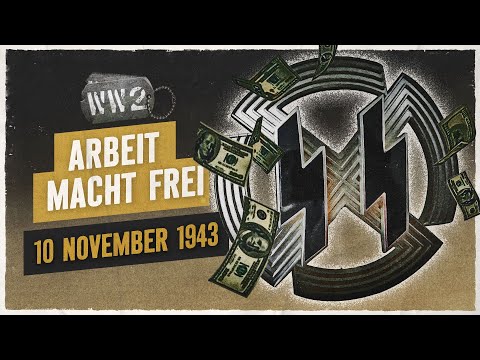The Auschwitz Business Model - War Against Humanity 086

November 13, 1943 This week it is twenty years since Adolf Hitler marched out of a beer hall in Munich at the head of a mob with the purpose to overthrow German democracy. Those who laughed at him then, are no longer laughing now - that is, if they have survived his rise to power. On that anniversary, Hitler holds his last ever public speech in person, and promises retribution on Great Britain, and the Jews.
This is War Against Humanity, a series of World War Two in Real-Time. I’m Spartacus Olsson. Last week, we saw the Japanese convene with their puppet states during the Greater East Asia Conference. Japanese-American internees in America protested their living conditions. Meanwhile, in Europe, Kiev was liberated by the Red Army, and Nazi horrors continued as 42,000 Jews were murdered in one day in the Lublin district during Aktion Erntefest.
In Germany 4000 people came to anti Nazi activist Father Bernhard Lichthenberg’s funeral after he died on his way to Dachau Concentration Camp. This week the Nazis get rid of more troublesome German priests Johannes Prassek, Eduard Müller and Hermann Lange are three Roman-Catholic priests at the Sacred Heart Church in Lübeck. Together with Lutheran pastor Karl Friedrich Stellbrink, they have cooperated to preach against the war since 1941. They have worked to spread Bishop von Galen’s protest letter against the T4 euthanasia program, woven anti-Nazi and anti-war allusion into their sermons, distributed transcripts from the forbidden German language BBC broadcasts, and held roundtable talks agitating against the war.
Right after Lübeck was hit by a British raid in the night leading into Palm Sunday 1942, Stellbrink used his sermon to frame the bombardment as God’s judgement saying that “God has spoken with mighty language - you will learn how to pray again.” The Gestapo reported that his words spread though the city like a wildfire, inspiring antiwar, and anti-Nazi sentiments. A week later Stellbrink was arrested, and the Lutheran church disavowed him and his actions. In the following weeks Fathers Prassek, Müller, and Lange as well as 18 of their congregation members were arrested. After a year in prison they were sentenced in June this year for a variety of crimes from infractions of the broadcasting law, to breaking the 1934 Treachery Act, to damaging the war effort. The 18 members of the Sacred Heart congregation received long prison sentences, and the four priests were condemned to death.
This week on November 10, three minutes apart beginning at 6:20 PM they are executed by guillotine at the Holstenglacis corrections facility in Hamburg. They are but a few of many priests, especially Catholic priests facing persecution, and murder by the Nazis. During the invasion of Poland in 1939, 3,000 Catholic priests were murdered in the purge of potential Polish resistance - another 1,811 have, or will die in various concentration camps during the war. Many of them are held at Dachau Concentration Camp in the Priest’s Block together with other potentially troublesome priests, pastors, and clergymen. In all 2,720 foreign clergymen, 1,773 of them Polish, and 400 German will pass through Dachau.
Over a thousand, 38% of them will not see the end of the war - as usual either murdered, or succumbed in the camp. But this week in Auschwitz it is the unusual death of 50 prisoners that heralds big change. Auschwitz Block 11 is the camp jail, In its cellar the first experiments with murder by Zyklon B gas were carried out on Soviet POW back in 1941. The top floor of three story building contains holding cells, torture chambers, and interrogation rooms. The ground floor contains administrative rooms, the court room for summary processes by the Gestapo and police, its waiting room, as well as latrines, and wash rooms. A door leads out to a walled-in court yard, and the Black Wall - used for shooting prisoners.
Back inside, a gated opening leads to the cellar with 28 cells, 14 on each side of a corridor, with cells 1-7 reserved for female prisoners. Cell 21 is reserved for very important prisoners. Cell 22 contains four standing cells - 90 by 90 cm - 35 by 35 inch walled-in cupboards that you have to crawl into though a square hatch along the floor.
Four prisoners are forced to enter the cell at once, meaning that you can neither lie, nor sit, nor crouch. The only ventilation is through a one inch squared hole in the hatch. Prisoners are kept here as punishment for infractions, or as part of interrogation.
Most times during the night, and then taken out for hard labor during the day. At times prisoners are held in a standing cell for days on end, often resulting in death by asphyxiation, exhaustion, or dehydration. Cells 23 and 24 are the darkness and hunger cells.
They are used as punishment cells, either for something the prisoner did themselves, or as retribution for some mass infraction. Here prisoners are kept in absolute darkness, often without any food, or water, at times more than a dozen together. They are also used as a means of slow execution, where the prisoners are simple left to die the excruciating pain of wasting away over several days.
You end up in Block 11, either because you are a political prisoner destined to be executed, or for a number of infractions like suspicion of or actual sabotage, resistance to the camp guards and Kapos, contact or suspected contact to civilians outside of the camp, possession of contraband food or objects smuggled into the camp, other infarctions against camp rules as deemed by the SS personal at their discretion, and planned, attempted, or failed escape. The latter is more frequent than one might expect from such a hard guarded facility as Auschwitz - every week half a dozen or more inmates try to escape, and on average about a third succeed - those who don’t will be punished and tortured in Block 11 for 3 to 28 days, and then released back into the general camp population. Why released, and simply not killed? Well, Auschwitz is by now part of a huge economically, and militarily significant business venture, one that needs labor. For the month of October, IG Farben, the biggest but not only client, paid the SS 488,949 Reichsmark for using the camp’s slaves.
The Wechsel Union Metallwerke, a smaller client paid 35,781 RM and so on. To put that in perspective; the average monthly salary in the Altreich - Germany and Austria proper - is in 1943 just under 200 RM. So with the money spent, IG Farben would get around 24 thousand work days from salaried laborers at home, Here at Auschwitz they get more than six times as much for their money - 150,259 labor days, out of which 38,410 days are by highly skilled workers.
Now, while that might sound like good business, SS Obergruppenführer Oswald Pohl, head of the SS Main Economic and Administrative Office is not happy. This week the camp records show that out of the 72,512 able bodied, work-ready men and women in the camp, 26,617 are currently unemployed. He blames the Camp Commandant Rudolf Höss, the architect of the terror of the camp, and pioneer of gassing with Zyklon B. Höss might be an expert torturer and mass executioner, but a businessman he is not.
Pohl also feels that the excessive violence under Höss command, as exampled in Block 11 is damaging business. So Pohl has decided that a more suave, business oriented SS man needs to hold the reins going forward. For that he has chosen one of his top mangers, the head of Abteilung D 1/Zentralamt, and deputy inspector of the Concentration Camps in Pohl’s organization - Arthur Liebehenschel. The 41 year old has four children by his divorced first wife, and his second wife has recently given birth to a little baby girl. Joining the NSDAP and SS one years before the Nazis seized power, he’s a veteran of the concentration camps and Totenkopfverbände. From 1934 to 1940 he served under Theodor Eicke, the man who invented the Nazi camp model, after which he has pursued a stellar career within the SS administration.
He’s a more diplomatic kind of monster than Höss - it was for instance Liebehenschel who came up with not mentioning the word “execution” when issuing awards to the SS men for distinguished service during mass murders, instead calling it “awarded for carrying out activities essential to the war.” In any case, a few days ago he arrived at Auschwitz, ostensibly for an inspection. He’s just waiting for the right moment to give Höss the good news - you see, Höss is being promoted away into a higher position at Pohl’s headquarters in Berlin - a cushy office job where he can learn more about how the new, business oriented SS works.
On November 9, the 20th anniversary of the attempted Hitler Luddendorf Putsch the moment comes. Höss has decided that it’s a good idea to execute some prisoners to celebrate the occasion, so he has 50 prisoners with political backgrounds from Block 11 selected, taken to the Black Wall, and shot in pairs. It creates some shockwaves even among the SS guards and employees - even for Auschwitz, this is considered a bit excessive. Höss himself is taken aback by the reaction.
Liebehenschel uses the moment to commend Höss for his service, gives him his promotion papers, and takes the reins. In a few days Höss and his family will relocate to Berlin, but already before that the new Commandant begins reforms in the camp, and especially in Block 11 to end the worst of excesses, because it’s better for business. He will abolish the standing cells, and end the use of the hunger cells. On the November 22 he will release 57 of the 83 prisoners held in Block 11 into the camp. The remaining 26 had been given death sentences, which Liebehenschel commutes to incarceration until further notice, and he orders the Black Wall dismantled. Inside the camp he will stop using violent criminals as Kapos, and only allow political prisoners in this role.
He will begin pursuing theft of victims’ personal property by the SS personnel, actually leading to that several of them will end up in Block 11 themselves. Again, not because he wants to protect the inmates, but because it’s good for business, I quote: “[the property] is state property. Only the state has power over its use.
Anyone who makes themselves available of state property is stealing from the state, is a criminal, and will be excluded out of the rows of the SS.” Let’s be clear of what property Liebehenschel is speaking of though: the property robbed from new arrivals - inmates in the camp have very little, if any personal property - mostly, we’re speaking of those destined to die on arrival in the gas chambers. Liebehenschel’s reforms follow Pohl’s directive from two weeks ago to increase productivity - and although that might slightly lessen the terror for the slaves, brutality, mass murders by gas, and medical experimentation will go on.
This week alone over 1,000 people from two larger transports will be murdered in the gas chambers on arrival. In Professor Clauberg’s gynecological experimentation clinic 387 women, mostly teenagers will continue to be subjected to hormonal experiments, radiation, and tortuous mutilation of their reproductive organs. The new commandant will not end the policy of selection of the able bodied for enslavement and murder of the rest, but he will try to keep his herd of slaves in slightly better condition, as they are now to be a repository for fresh slave labor to be shipped to where it is needed - already this week the transports to Mauthausen are increased. As is the nature of the Nazi German war, most of the victims are Jewish, or considered to be Jewish. In the United Nations outside of continental Europe, specifically the British Commonwealth and the US, any relief to aid them, by for instance accepting Jewish refugees has been largely absent until now.
In the US, the Emergency Committee to Save the Jewish People of Europe, led by Peter Bergson have been actively campaigning for that to change since beginning of the year. They’ve been met with inaction, indifference, and direct opposition. Even some Jewish Americans are opposed to Bergson’s effort, considering it too aggressive, believing it to have given rise to an anti-Semitic backlash. But this week, Senator Guy Gillette introduces Resolution 203, which calls for “the creation by the President of a commission of diplomatic, economic and military experts to formulate and effectuate a plan of action to save the surviving Jewish people of Europe from extinction”. Bergson ups the rhetoric, taking out ads saying “HOW WELL ARE YOU SLEEPING”? And “THIS IS STRICTLY A RACE AGAINST DEATH.” How effective this will be remains to be seen, but elsewhere plans are now being made for the general aid to be given to civilians as Asia and Europe are gradually going to be liberated.
On the same day Senator Gillet’s resolution is introduced, the United Nations Relief and Rehabilitation Administration is created. They will begin preparations to supply food, clothing, shelter, and medical aid, and to rebuild infrastructure, agriculture, industrial production facilities, and essential buildings like hospitals and schools. Furthermore, arrangements are to be made to return POW, exiles, and enslaved people home. Unfortunately for the people of Bengal, British India they are inside a UN member nation’s territory and will not see any of this relief. The new viceroy of India, Archibald Wavell, has asked Secretary of State for India, Leo Amery to make renewed request for the long promised monthly delivery of 50,000 tons of food grains to finally begin next year, and for 50,000 additional tons to be shipped from Australia immediately. Meanwhile Canadian Prime Minister McKenzie King offers to send 100,000 tons of wheat, ready to depart on November 12.
All they need is the British Prime Minister’s Winston Churchill’s OK. On November 10, the British War cabinet convenes about Amery’s initiative, and the Canadian offer. But Churchill is still not keen to go down this route. The PMs advisor Frederick Lindemann has argued that the Bengal Famine is a result of ‘over-breeding’ despite restraints in the availability of food to sustain this population, let alone population growth. During the War Cabinet meeting Churchill repeats the complaint saying that the Indians are “breeding like Rabbits.” The cabinet decides that shipping food is futile, impractical, and cannibalizes the war effort.
The offer of 100,000 tons from Canada is turned down in order to allow the shipping capacity to be ‘utilized to better effect’. The man ultimately responsible for creating this mess, the man who four years ago launched the invasion of Poland, and catapulted a world under threat of war, and already at war into a global conflict - German Führer Adolf Hitler is rarely, if ever seen in public these days. Most of the time he is inside the Wolfsschanze, his bunker complex in the forests near the village Görlitz in East Prussia. Here he hides from his enemies, from the bombs, and perhaps from the reality he has created. But on November 7, he leaves the lair in his private train, and travels to Munich via Nürnberg. During his stopover in Nürnberg he receives his situation reports, has a haircut, meets with General Zeitzler, and then eats lunch with his personal photographer Heinrich Hoffman.
Before the train leaves the Nürnberg station his personal physician, Doctor Morell, injects the Führer with the afternoon portion of his daily medicine, vitamins, and narcotics cocktail. The train arrives Munich at 16:10, and fifty minutes later he is standing in front of a few thousands of Nazi followers in the Löwenbräukeller. It is November 8, 1943 - the eve of the twentieth anniversary of his failed putsch attempt. When he begins to speak, his tone is measured, and calculated, absent his fanatic energy of most of his past speeches.
“Almost one-third of a human being’s lifetime has passed since the day that we commemorate today and in celebration of which I have returned for a few hours to your midst.” While reiterating the false narrative of victimhood of Germany in the past thirty years, celebrating the great success of Naziism, litigating his corrupt enemies, and lauding the invincible strength of the German race, he once again, repeatedly frames the war as a conflict of the German Race versus Judaism. “It is more than anything complete ignorance of mainly mainstream politicians, when in many countries it is the belief that the Jewish Plutocratic West can overcome the Jewish-Bolshevist East.
No! The very opposite will happen: one day the Jewish-Bolshevist East, will alleviate the Jews of the west of their task to hide in hypocrisy. It can then in all openness declare its final goal. You see, the Jewish democracy of the West will sooner or later end in Bolshevism. […] One thing, my party comrades is certain: without November 9, 1923 the National Socialist Movement would never have become what it is. Without the National Socialist Movement there would not be a strong German Reich today, and without a doubt, without that German Reich, undoubtedly the militarily most effective state in Europe, there would already now not be any future for Europe.
That in this war, once again England is the driving force, that in its origin, outbreak, and transaction they have united with the Jews, is only a repetition of the events of the First World War. However, that such gigantic historical events cannot twice lead to the same result is to be taken as a certainty when the balance of power then, is compared to now.” The Führer then expresses his sympathy with the German people suffering under United Nations bombing. Reassures them that the fighting power and industry of Germany remains effectively unchanged. Appeals to their fighting will and patriotism. Promises that a rebuilt Germany will be a stronger Germany, and swift, and terrible retribution against the British very soon.
He is, of course speaking of the V weapons - the cruise, and ballistic missiles that he plans to rain down over the cities of Britain. In their assessment of the public reaction to the speech the SS will determine it to have done its job. The long overdue appearance of the Führer in person, and a national radio broadcast was what was expected - the promise of vengeance on the British was what everyone was hoping for. By the time his voice is being sent out through the ether, Hitler is having dinner with the Reichsletern and Gauleitern in the Führerbau, his palatial Munich offices. At midnight he retires to his private apartment in Prinzregentenstrasse.
The next day after having lunch at the Osteria Bavaria, his favorite restaurant, he returns to East Prussia to hide in his lair. He will never return to his private apartment in Munich, and this will be his last public address in person. It is the conclusion of twenty years that began with his violent march on democracy, and failed insurrection. A day when Germany looked on with a mixture of mild horror, and bemusement.
The old Prussian Luddendorf booed out of Bavaria like a hand-puppet caricature villain. Hitler absconded with his tail between his legs, while his comrades unsuccessfully combatted the police at the Feldherrenhalle. Göring shot in the ass. A party of brutish clowns that’s seemed so incoherent, and incapable of anything serious that the event was soon forgotten, as Germany moved on into the heady days of the golden twenties. Just another passing shadow cast in a time of deep political divisions. Just another challenge to democracy averted.
Better to move on, slap the perpetrators with some minimum prison time, and shrug it off for the sake of unity and peace. But two decades later the silly, choleric man with the loud voice, and a Charlie Chaplin mustache has long risen from the ashes. Now, while he retreats into his burrow the world burns around him, consuming both his foes and friends. A world ignited by his flaming rhetoric based on conspiracy delusions, lies, and hatred. It shows us that even when it’s a clown pose attacking democracy, it’s no laughing matter.
Never Forget
2022-11-13 08:05


